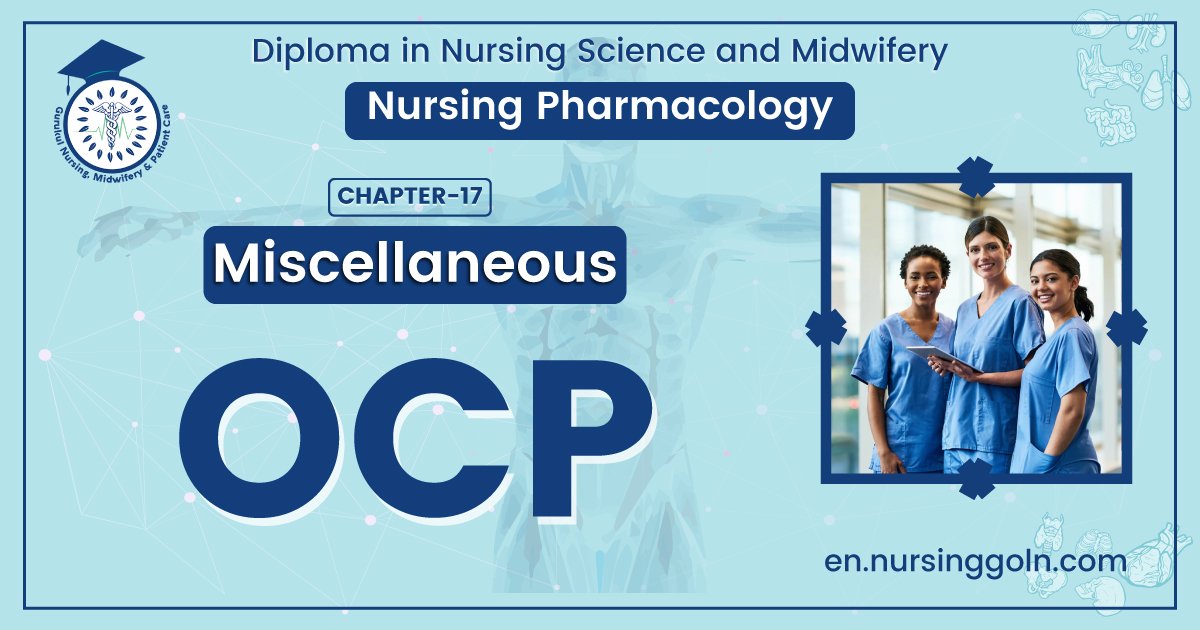Concept About OCP – This book covers the entire syllabus of “Pharmacology” prescribed by BNMC- for diploma in nursing science & midwifery students. We tried to accommodate the latest information and topics. This book is an examination setup according to the teachers’ lectures and examination questions.
At the end of the book, previous questions are given. We hope in touch with the book students’ knowledge will be upgraded and flourish. The unique way of presentation may make your reading of the book a pleasurable experience.

Concept About OCP
Definition of OCP (Oral contraceptive pill):
Oral contraceptives, abbreviated OCPs, also known as birth control pills, are medications taken by mouth for the purpose of birth control.
Or,
OCP mean Oral contraceptive pill. Hormonal contraceptives used are the most effective spacing methods of contraception. Oral contraceptives of combined types are almost hundred percent effective in preventing pregnancy.
Types of OCP (Oral contraceptive pill):
A. Combined pills :-It is 100% effective, Contain oestrogen and progesterone
B. Mini pill:- It is 97-98% effective, it contain only progesterone
C. Morning after pill
D. It contain only oestrogen
Mechanism of Action Of OCP:
The main mechanism of action are the inhibition of follicular development, ovulation, and as consequence, corpus luteum formation. Further, it is also involved in the alteration of the cervical mucus that inhibit sperm penetration.
Advantages of OCP (Oral contraceptive pill):
1. 99% effective- low failure rate (0.1/100 w.y)
2. Aesthetically attractive.
3. Sense of well-being.
4. Not interference with sexual act
5. Reversible.
6. Reasonably cheap & available..
7. It is self-administered.
8. Does not impair subsequent fertility.
9. Some nor-contraceptive advantages eg. protection against:
- Benign breast disease
- Fibroadenoma of breast
- Endometriosis
- Ovarian carcinoma
- PID
- Iron deficiency anaemia
- Dysmenorrhoea
- Premenstrual tension
- Idiopathic hirsuitism
Disadvantages/Adverse Effect/ Side Effect/Complication of OCP:
A. Minor disadvantages:
1. Nausea & vomiting.
2. Weight gain.
3. Break through bleeding or spotting.
4. Reduced menstrual bleeding.
5. Absence of withdrawal bleeding.
6. Others- headache, dizziness, breast tenderness, abdominal cramps, emotional changes
such as depression.
B. Major disadvantages:
| 1. Cardiovascular effects | OCP causes increased risk of
|
| 2. Metabolic effects |
|
| 3. Hepatic effects |
|
| 4. Psychological effects |
|
Indications of Oral Pill:
A. Contraceptive use.
B. Non-contraceptive uses / benefits:
- To reduce premenstrual tension.
- Dysmenorrhea.
- Abnormal uterine bleeding.
- Dysfunctional uterine bleeding.
- Functional ovarian cyst.
- Benign breast disease.
- Sterility.
- Endometriosis.
- Menopause.

Contra-Indications of OCP:
| 1. Absolute(WHO category-4) | History of CVS disease Liver disease (ch. Hepatitis) Breast cancer DVT Pulmonary embolism Migraine Liver adenoma |
| 2. Relative(WHO category-3) | HTN Obesity Migraine Endogenous smoking Heavy smoking Unexplained vaginal bleeding Past breast cancer |
| 3. Special precaution(WHO-2) | DM Collagen diseases Osteosclerosis Severe varicose veins Sickle cell disease Surgical operation History of depression Age over 35 years. Cancer cervix or CIN |
To select a patient for prescribing OCR through history, examination and some investigations are needed to exclude contra-indication.
A. Age of the patient is important.
- If she is more than 35 years of age she should be prescribed with caution & regular checkup is needed.
- In smokers it is to be prescribed with caution as it is associated with increased incidence of thromboembolism.
B. Menstrual history is to be taken to exclude pregnancy, undiagnosed uterine diseases etc.
C. Family history of cerebro-vascular disease including hypertension, breast cancer & hyperlipidaemia should be excluded. D. Medical history regarding thrombo-embolic episodes, jaundice, epilepsy, HTN, DM, allergic condition, migraine should also be-excluded
E. Examination of breast for any nodule. Blood pressure and weight should be noted.
F. Pelvic examination to exclude fibroid or cervical pathology is manditory.
G. Investigation vaginal cytology if facilities are available.
From the above mentioned examination to screen if it is revealed that the woman is free from any systemic disease and contraindication she is suitable candidate for OCP therapy.

Minipill:
Minipill is devoid of oestrogen compound. It contains very low dose of a progestin in any one of the following form-
- Levo norgestril 75mg or Norethisterone 350mg
- Desogestril 5mg, lynesterol 500mg or Norgestril
Mechanism of action:
It works mainly by making cervical mucous thick and viscous, thereby prevents sperm penetration Endometrium becomes atrophic, so blastocyst implantation is also hindered. In about 2% of cases ovulation is inhibited.
How to prescribe minipill:
The first pill hasMo be taken on the first day of the cycle and then continuously. It has to be taken regularly and at the same time of the day. There must be no break between the packs.
Advantages:
- Side effects attributed to oestrogen in combined pill are totally eliminated.
- No adverse effect on lactation
- Easy to take
- It may be prescribe in patient having, hypertension, fibroid, diabetes, epilepsy and
- H/O thromboembolism.
- Reduces the risk of PID and endometrial cancer.
Name of Available OCP:
| Commercial name | Estrogen | Progesterone |
| Shukhi (28) | Ehinyloestrodiol 30mcg | Levonergestrel 150 mcg FeSO4 75 mg |
| Ovacon (28) | Ethinyloestrodiol 35mcg | Norathindorne 150mcg FeSO4 75mg |
| Maya (28) | Mestranol 50 mcg | Norathindorne 150mcg FeSO4 75mg |
| Norquest (28) | Ethinyloestrodiol 35mcg | Norathindorne 150mcg FeSO4 75mg |
| Ovostate(21) | Ethinyloestrodiol 35mcg | Lynestrenol 100mcg |
| Marvelon (21) | Ethinyloestrodiol 35mcg | Desogestrel 150mcg |
Read more:
